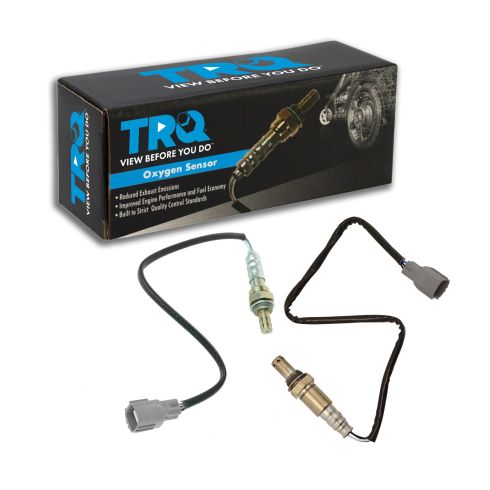1AEEK00851-Toyota Lexus Pontiac 2 Piece O2 Oxygen Sensor Set TRQ OSA61647

Replaces
2010 Toyota Avalon V6 3.5L Upstream & Downstream 2 Piece O2 Oxygen Sensor Set TRQ OSA61647

Product Reviews
Loading reviews
3.54/ 5.0
13
13 reviews
oxygen sensor 2006 toyota rav4
September 18, 2018
After replacement it is worse oxygen sensors is no good get my money back
07 Camry oxygen sensors
October 14, 2018
The sensors are a direct fit and went in with no problem ....The car has been running good so far ,its been 4 weeks since install...The price was about half of my local parts stores ....My one complaint would be that the sensors are not labeled up or down stream so you have to figure that out ...not a big deal pretty easy to tell the difference ...thank you 1aauto.com
Perfect fit
January 12, 2019
These sensors arrived on time and in perfect condition. Pricing is great!! The only reason it's a four star review is, I think as a package they should slip a piece of paper in stating which code is for the upstream and which is for the downstream sensor. Wire length was the key factor when I took them out.
Oxygen sensor
May 8, 2019
My experience went like this. My first order got lost I was told after waiting around 8-10 days. When it arrived and my mechanic installed the 02 up stream sensor it didnt work. I was sent a new one. My mechanic told me ot doesnt fall into the parameters Of voltages required.. buy from the parts store a Denso product. It worked. When I went to retune them I was asked for my VIN NUMBER. Donna realized I was sent the wrong sensors. She said I would be sent an email in Three to five days showing a credit given in the full amount. $119.95. 1A Auto corrected their mistake and I will be buying from them again when I need car parts. I will be looking for my credit in the coming days. My rating wouldve been better but I had to pay my mechanic and rent a car. For four days. Thanks for asking. Jon
Oxygen SENSORS TOYOTA CAMRY 3012 SE
August 17, 2019
Priced this part at dealership and 3 local auto parts store. Their price 161.00 Plus tax, plus shipping or labor over est 200.00 for 1 sensor. Got 2 sensors for 128.05 tax included. Free shipping! I replaced 1 sensor on top and my son replaced the 1 on bottom of engine. Gas milage improved from 24.5 city/ highway to 30 mph. Mom-n- son ready to do next project!
August 21, 2019
The 02 sensors worked well for about a week now my car won't start
O2 sensor
March 1, 2020
I would give a higher rating but, I just installed the sensors.
July 14, 2022
Came on time.??
August 5, 2022
Fast delivery and product shipped in very good condition
May 7, 2023
Fast shipping good quality I recommend it replaced it and my coats when awayFive stars
O2 sensors 2011 Camry
July 15, 2023
Exactly what I needed, when I needed them, at the price I needed. They even came with anti-seize already on the threads. Like others, I wish they were labeled, but I figured it out based on cord length. Cleared the codes and I'm off! Hoping to get better performance, but not banking on it.
Another nice touch is the set of comprehensive videos, which brought me to the website many years ago. Definitely going to be my go-to for parts.
Good quality parts
November 16, 2023
Part good quality but there was no video on how to replace the O1 S1 on a 2006 Toyota Camry V6, Near the firewall.
2011 Rav4 Limited 3.5l V6 is overall satisfied.
March 26, 2024
The connector was not compatible with 1 O2 sensor. Bank 1 Sensor 2. Had to splice them together. Bank 2 Sensor 2, connectors looked identical, however, the grooves and ridges that permit specific insertion were not allowing my OE connector connect. So, I made it work in the end.
Customer Q&A
Are these sensors made by Denso?
July 4, 2019
10
No, aftermarket parts.
July 4, 2019
A R
10
Unfortunately, no, John. I recommend either buying directly from Denso, or shopping Amazon. I had to return the downstream sensor because it was not for my vehicle. I only received a partial refund.
July 4, 2019
J B
Is it Denso made?
November 11, 2019
10
1A Auto's house brand parts are manufactured by various aftermarket companies specifically for us and built to your vehicle's exact OEM specifications. Please let us know if you have any other questions.
November 11, 2019
Emma F
Is there a video tutorial on doing the downstream one too or only upstream? (New to learning about cars )
May 31, 2020
10
Hello,
You can search our youtube channel for that video. We may have a video for your vehicle. Thanks!
June 1, 2020
Adam G
What size is the threads if 02 sensor?
February 7, 2022
10
Actual Measurements are not listed or available. Our parts are exact replacements for your vehicle's OEM parts. As long as your year, make, and model match up with our listing, these parts will directly fit and function like the originals.
February 7, 2022
Emma F
Will these sensors fit 2001 Toyota Camry 3.0 v6?
October 5, 2024
10
No, this set will not fit. Please confirm which sensors you need and if your vehicle has an automatic or manual transmission. We can then check to see if we carry the right parts.
October 7, 2024
Andra M
Toyota is a registered trademark of Toyota Motor Corporation. 1A Auto is not affiliated with or sponsored by Toyota or Toyota Motor Corporation.
See all trademarks.






















